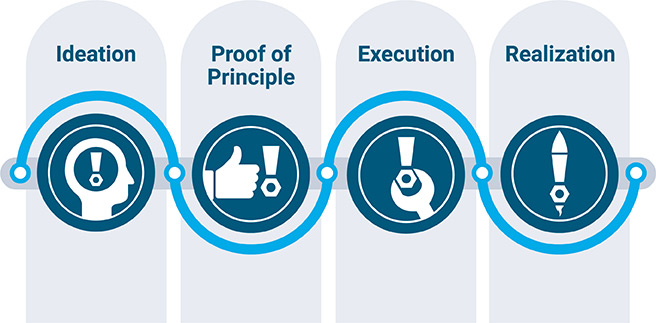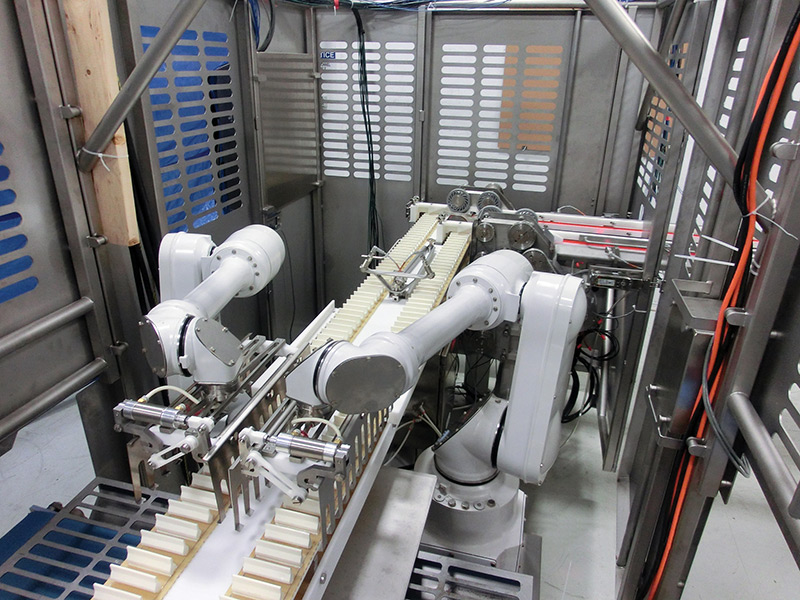This rigorous process mitigates risks and enhances the entire production environment.
By Joseph Spychalla, Lead Mechanical Design Engineer and Machine Development Lab Coordinator at Foth
Taking the proper steps to prove a concept works is common to most manufacturing innovation processes. Some projects require special rigor, especially when the challenge at hand requires a first-of-a-kind solution. That’s why Foth has developed its own dedicated process to establishing Automated Manufacturing Solutions (AMS).
The beauty of the AMS process is that it focuses a team’s attention on the most critical aspect, requiring a resolution to the trickiest problem first, before addressing other important aspects of the solution.

The foundation of the four-step AMS process is the client’s primary business goals. Unlike routine equipment upgrades and additions where the concept has been well documented and scoped, the AMS process starts with a challenge or goal for which there is no immediately available solution.
The vast range of need across manufacturing facilities, even within the same industry, creates an environment that requires customized solutions. For example, new product development might require specialized machines in a production line, or a stand-alone machine that handles a unique component. Sustainability goals, fluctuations in the labor force, and increased demand might create a desire to simplify a line and combine the work of multiple machines or replace legacy equipment to optimize capacity. And on some occasions, an entire production line needs to be modernized due to evolving trends and regulations.
Before diving into the concept phase, everyone must be aligned and understand both the challenge and what defines success.
With a deep understanding of the need, the four-step AMS process enters Phase 1: Concept Development & Feasibility. An interdisciplinary team is assembled consisting of electrical and mechanical engineering, information technology, legal/intellectual property, ergonomics, safety, and packaging, among others.
Additional team members often include the client’s subject-matter experts, as well as external industry experts. With the team in place, the rules of engagement are established, which include an unbiased view of the need and an openness to ideas that solve the problem.
Now the gears start turning. A typical concept development and feasibility phase produces at least three viable solutions, including the pros, cons, and risks of each. From there, we present our recommendation, which heavily relies on our analysis and evaluation of the facts to point to the best option.

With the client’s approval, we enter Phase 2: Proof of Principle & Preliminary Engineering. This risk mitigation exercise focuses on vetting the concepts from Phase 1.
The team considers the most viable concept and finds ways to mitigate the risks. We attack the biggest risk first and ‘fail fast’ at possible solutions, avoiding the tendency to force-fit any one solution path.
Mock-up approaches vary considerably. From simply dropping product from various heights to learn how it will respond in an automated packaging process, to building elaborate models to test and optimize machine performance. Often, high-speed cameras and other measurement equipment are necessary to gather data and objectively evaluate concepts.
We find it’s important to adopt a system-level view of the client’s process and specific challenges. One client had a legacy machine that had worked well for years, but wanted it modernized. With our system view, we not only built the new machine, but found additional ways to optimize their production efficiency, safety, and ergonomics.
Our experience has shown that most projects require an iterative approach, where potential solutions fail fast but don’t kill the project. After adjusting the approach, 90% of the time we find a solution that works at-speed in the client’s environment. For example, a client once challenged us to automate the process of placing oddly-shaped lollipop sticks in molds of liquid candy. Initial ideas failed, but those failures quickly led us to a successful solution that the client is now using to mass produce their product.
Upon successful conclusion of proof-of-principle and preliminary engineering, we confidently move to Phase 3: Engineering and Manufacturing. Fortunately, these two steps were carefully considered during the concept development phase. With a cross-functional team, downstream interests are represented early in the process.
This phase expands the team to tackle the bulk of the design effort including the lower-risk items that may not have been fully mitigated previously. The team is also likely to add procurement and manufacturing resources.
The final phase includes a factory acceptance test (FAT) before the field support team begins installation and startup. The team includes members with the expertise needed at this stage, along with the original design engineers to maintain continuity.
Here the rigor applied at the proof-of-principle step really pays off because the team already knows the solution works. They stay on site until startup is complete to minimize production line downtime.
We know proof-of-concept methods are widely used in problem-solving approaches. In fact, Industry Today reported on one firm that used this method to develop a solution to significantly reduce its labor costs [How PGC Reduced Its Labor Costs by 50%].
Foth’s AMS process stands out because of the rigorous way we implement the proof-of-principle phase to go the extra mile and produce automation solutions for even the most challenging situations.
If you have a head-scratching automation challenge, the core AMS team is available any time to explore ways our proof-of-principle approach will work for you.

Joseph Spychalla combines more than 20 years of conceptual and detailed mechanical design and development engineering experience with project management excellence to consistently deliver the best possible automation solutions. Joseph has successfully led projects developing first-of-a-kind machines for both industrial automation and aerospace electro-mechanical actuation. While focused on the entire project lifecycle, including manufacturing, assembly, and installation, Joseph has a particular interest in the development of prototypes, machine testing, and the proof-of-principle process. https://www.foth.com/contact-foth/
Scott Ellyson, CEO of East West Manufacturing, brings decades of global manufacturing and supply chain leadership to the conversation. In this episode, he shares practical insights on scaling operations, navigating complexity, and building resilient manufacturing networks in an increasingly connected world.